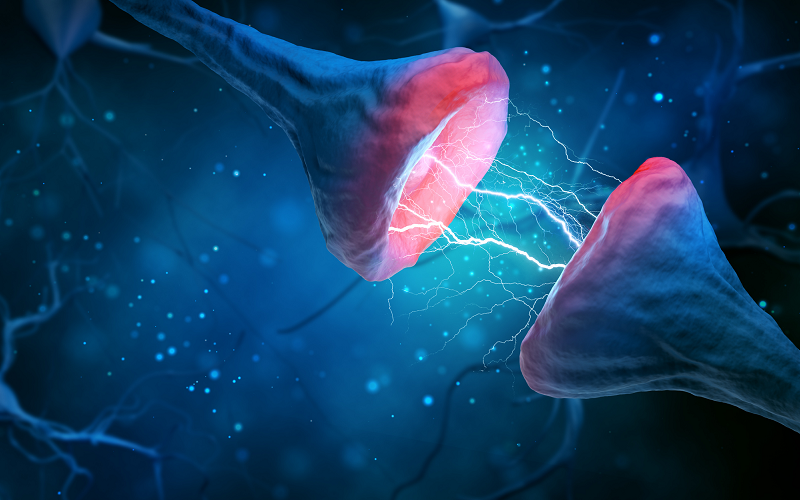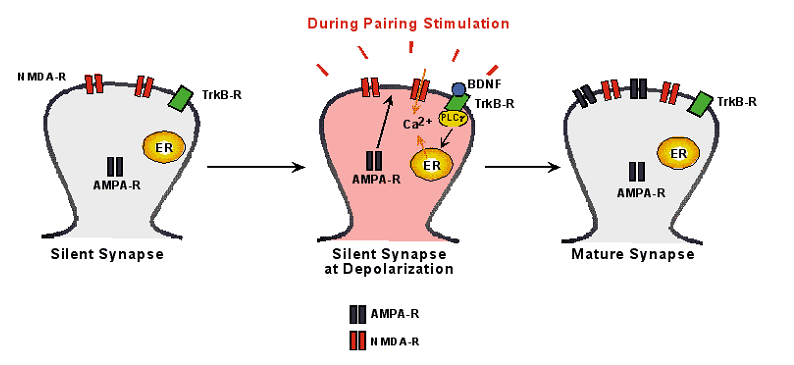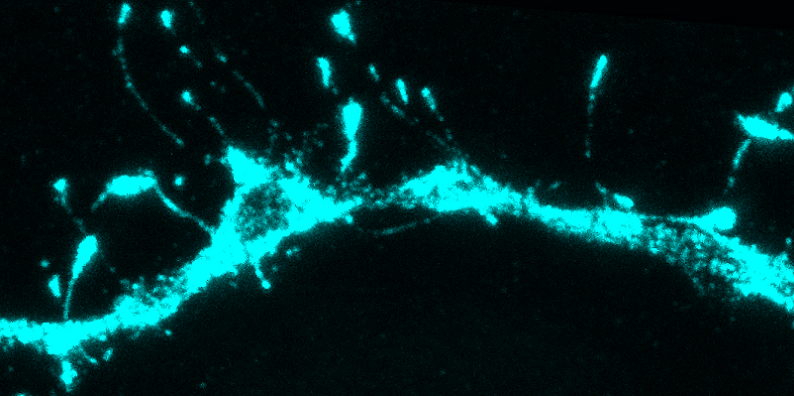
If you’ve ever wondered how your brain is so adept at learning new skills or why certain memories stick while others fade, the secret may lie in silent synapses, the enigmatic connections within your neural circuitry. Synapses are the bridges that allow neurons to communicate with each other, serving as the highways of information in our brains.
While most synapses are “active,” transmitting signals to facilitate various forms of cognition and bodily functions, there exists a mysterious class known as “silent synapses.” Though silent, they are far from insignificant; these unique connections hold secrets that are essential for understanding how our brain functions and evolves.
Contents
Introduction to Neurons and Synapses
The human brain, a marvel of biological engineering, contains an intricate network of neurons connected by synapses. These connections serve as the essential circuits that enable everything from our ability to ponder the mysteries of the universe to simply recalling where we left our keys. Among these, a particular class of synapses — known as “silent synapses” — has captivated the attention of neuroscientists and researchers. Why? Because they might just be key players in brain function, learning, memory, and even in the onset of neurological diseases.
Definition of Neurons and Synapses
Before we dive into the world of silent synapses, it’s important to establish what neurons and synapses are. Neurons are specialized cells in the nervous system responsible for transmitting information. These cells communicate through synapses, small gaps where neurotransmitters—chemical messengers—are released to pass signals from one neuron to the next.
The Role of Synapses in Brain Function
Synapses are not just microscopic gaps but are vital junctions that facilitate complex cognitive tasks. They are involved in everything from helping you remember names and faces to enabling your ability to read this blog post. Each synapse can either be excitatory, promoting the generation of a new signal, or inhibitory, reducing the likelihood of a new signal. These excitatory and inhibitory processes help to maintain the brain’s overall equilibrium and functionality [1].
Introduction to Silent Synapses
Now that we have a basic understanding of neurons and synapses, let’s introduce our stars of the day—silent synapses. Unlike traditional, or “active,” synapses, silent synapses don’t transmit signals under normal conditions. They are like dormant volcanoes in the neural landscape, quietly awaiting certain conditions to become active.
Importance of Understanding Silent Synapses for Cognitive Health
Understanding silent synapses is not just academic navel-gazing; it has real-world implications for cognitive health. Studies suggest that these synapses play crucial roles in neural plasticity, which is essential for learning and memory. They are also implicated in various stages of development and could be key players in neurological disorders like Alzheimer’s and Parkinson’s diseases.

What Are Silent Synapses?
If we think of the brain as a complex computer network, silent synapses are like unused ports that can be activated when needed. They hold potential for activity, but under regular circumstances, they stay dormant. What makes them unique? How do they differ from active synapses? And where can we find these silent synapses within the brain?
Definition of Silent Synapses
Silent synapses are neuronal connections that are functionally “silent” under basal conditions, meaning they don’t transmit synaptic signals unless certain conditions are met. Unlike their active counterparts, which readily transmit signals from the pre-synaptic neuron to the post-synaptic neuron, silent synapses have a restricted ability to let the signals pass through. They are, in essence, potential connections waiting to be awakened.
Structural Components
To better understand silent synapses, it’s crucial to break down their structural components. Like any other synapse, a silent synapse comprises three main parts: the pre-synaptic neuron, the post-synaptic neuron, and the synaptic cleft. However, the composition of these components in silent synapses may differ slightly.
Pre-synaptic Neuron
The pre-synaptic neuron in a silent synapse is much like that in an active synapse; it houses neurotransmitter-filled vesicles ready for release. However, these neurotransmitters often don’t get a chance to complete their journey across the synaptic cleft because the post-synaptic side is not fully responsive.
Post-synaptic Neuron
Here lies the major difference between active and silent synapses. The post-synaptic neuron in a silent synapse lacks the sufficient number or type of receptors that would normally allow it to respond to the neurotransmitters released from the pre-synaptic neuron.
Synaptic Cleft
The synaptic cleft is the minute space that separates the pre-synaptic and post-synaptic neurons. In silent synapses, this space functions similarly to how it does in active synapses, serving as the arena where neurotransmitters can potentially cross to deliver their message.
Comparison with Active Synapses
Now that we understand the basic structural elements, how do silent synapses differ from active ones? The primary difference is in the readiness of the post-synaptic neuron to receive signals. In an active synapse, neurotransmitters released from the pre-synaptic neuron bind readily to receptors on the post-synaptic neuron, resulting in an electrical signal. In silent synapses, this doesn’t usually happen unless certain conditions are met, which often involve the “maturation” or modification of the post-synaptic neuron [2].
Existence in Various Brain Regions
You might be wondering, where can we find these silent synapses? While initial studies on silent synapses were concentrated in the hippocampus—a region vital for learning and memory—further research has shown that they exist in many other regions of the brain. They have been identified in the cerebral cortex, the amygdala, and even the spinal cord, indicating their widespread presence and potential roles in various cognitive and bodily functions.

Discovery and Historical Context of Silent Synapses
Understanding the history of the discovery of silent synapses not only adds a layer of intrigue but also helps us appreciate the complexity and evolution of neuroscience as a field.
Early Observations
The concept of silent synapses was not immediately recognized but emerged over years of research on synaptic transmission and neural plasticity. Initial observations that led to the discovery of silent synapses were somewhat puzzling. Scientists found that certain synapses seemed to be inactive during experiments, even though they appeared structurally similar to active synapses. These enigmatic synapses would sometimes “wake up” and become active under specific conditions or after certain kinds of stimulation, sparking curiosity among neuroscientists.
Experimental Methods Used in Discovery
Discovering and studying silent synapses was no small feat and relied heavily on advanced experimental techniques. Some of the methods used in the early days and even today include:
- Electrophysiology: Utilizing electrodes to measure synaptic activity provided some of the first insights into the presence of silent synapses.
- Optical Imaging: Advanced imaging techniques helped researchers visualize these synapses, aiding in the identification of their unique structural components.
- Genetic Manipulation: By modifying specific genes in animal models, scientists have been able to induce or eliminate silent synapses to study their functions.
Contribution to the Field of Neuroscience
The discovery of silent synapses was groundbreaking for multiple reasons:
- Enhanced Understanding of Neural Plasticity: The existence of silent synapses offered a new dimension to understanding how the brain adapts and learns.
- Implications for Development: Researchers realized that the number of silent synapses changes over various developmental stages, offering insights into brain development from infancy to adolescence.
- Clinical Applications: The study of silent synapses has also led to potential new approaches to treating neurological conditions.
Mechanism of Action of Silent Synapses
How do silent synapses stay silent, and what causes them to become active? What are the molecular and cellular mechanisms behind their unique characteristics? Understanding these mechanisms can offer us even deeper insights into the roles of silent synapses in brain function, plasticity, and potentially, pathology.
Molecular Basis of Silence
At the core of a silent synapse’s quiet nature is its unique molecular configuration. As mentioned earlier, the post-synaptic neuron in a silent synapse typically lacks certain receptors, making it less responsive to neurotransmitters [3].
Types of Receptors
To understand the silence, we need to talk about receptors. The two primary types of receptors involved in synaptic transmission are AMPA receptors and NMDA receptors. Active synapses usually contain both, while silent synapses often lack AMPA receptors but do contain NMDA receptors.
NMDA vs. AMPA
Why is the presence of NMDA receptors but not AMPA receptors significant? NMDA receptors are voltage-dependent, meaning they require a certain level of electrical activity to become activated. AMPA receptors, on the other hand, are not voltage-dependent and can activate more easily. This difference is crucial for a synapse’s transition from silent to active.
Activation Triggers
So, what can turn a silent synapse into an active one? There are a few known triggers.
Sensory Experience
Real-world experiences can cause silent synapses to activate, contributing to learning and memory.
Developmental Stages
As an individual grows, biochemical changes can naturally convert silent synapses into active ones, especially during periods of rapid learning.
Synaptic Plasticity
High-frequency stimulation can lead to long-term potentiation (LTP), a form of synaptic plasticity that can convert silent synapses into active ones by inserting AMPA receptors into the post-synaptic neuron.
Pathways to Activation
Upon receiving the right triggers, several intracellular pathways may come into play to change a silent synapse’s status.
AMPA Receptor Insertion
The most straightforward way a silent synapse becomes active is through the addition of AMPA receptors in the post-synaptic membrane, allowing it to respond to neurotransmitters effectively.
Receptor Modification
Sometimes, instead of adding new AMPA receptors, the existing NMDA receptors may undergo modifications to become more responsive.
Local Protein Synthesis
In some cases, local protein synthesis near the synapse can lead to changes that make the synapse active.
Implications for Neural Plasticity
Understanding the mechanisms that switch silent synapses on or off can offer valuable insights into neural plasticity. Activation of silent synapses has been shown to be a crucial process underlying synaptic strengthening and, consequently, learning and memory. It essentially provides the neural circuitry with a form of “metaplasticity,” allowing for a more dynamic and adaptable response to environmental stimuli.

Functional Significance of Silent Synapses
What purpose do these silent synapses serve? Indeed, their existence and unique properties have to fit somewhere in the grand scheme of brain function and cognitive health. The functional significance of silent synapses stretches across various cognitive domains, from learning and memory to emotional regulation.
Role in Learning and Memory
One of the most compelling areas of research regarding silent synapses is their role in learning and memory. As previously mentioned, silent synapses can become active through processes like long-term potentiation, which is central to forming new memories [4].
Memory Formation
In regions of the brain like the hippocampus, activation of silent synapses during specific learning tasks has been observed. This activation is thought to strengthen neural circuits, facilitating the formation of new memories.
Cognitive Flexibility
Not only do silent synapses contribute to memory formation, but their ability to activate or remain silent gives the neural network a form of flexibility. This flexibility may allow for more nuanced learning experiences and adaptation to new information.
Emotional Regulation and Stress Response
Silent synapses are not exclusive to regions of the brain involved in learning and memory. They’ve also been identified in areas responsible for emotional regulation, such as the amygdala.
Mood Disorders
Research has suggested that dysfunction in the activation or maintenance of silent synapses could potentially contribute to mood disorders like depression and anxiety. The balance between active and silent synapses might play a role in emotional resilience and susceptibility to stress.
Stress Adaptation
The ability of synapses to transition between silent and active states might also be crucial for adaptive stress responses. Silent synapses could provide a “buffer” that allows for more gradual changes in neural activity, contributing to better emotional regulation.
Developmental Importance
The existence and activation of silent synapses have also been observed to vary across different developmental stages, from infancy to adolescence and into adulthood.
Brain Development
During periods of rapid brain development, the ratio of silent to active synapses changes, suggesting a role in the formation and fine-tuning of neural circuits.
Learning and Plasticity in Early Life
The activation of silent synapses in early developmental stages might contribute to the high levels of neural plasticity observed in young individuals, aiding in complex cognitive functions like language acquisition.
Clinical Implications
Finally, the study of silent synapses is not just academically interesting; it has real-world clinical implications.
Neurological Disorders
Understanding how silent synapses work could pave the way for new treatments for neurological conditions, such as Alzheimer’s disease, where synaptic dysfunction is a key feature.
Mental Health Treatment
Likewise, insights into the role of silent synapses in emotional regulation could offer novel approaches for treating mood disorders.
Silent Synapses Importance for Cognitive Health
By this point, we’ve examined silent synapses from various angles — what they are, how they were discovered, the mechanisms behind their function, and their roles in learning, memory, and emotional regulation. But how does all this information tie back to cognitive health? As it turns out, the understanding of silent synapses is not just an academic endeavor; it has direct implications for how we think about and maintain cognitive health throughout the lifespan.
Age-Related Cognitive Decline
One of the most pressing concerns in cognitive health is how to preserve mental acuity as we age. Research has shown that the activity and even the number of silent synapses can change with age.
Synaptic Aging
As we grow older, the neural plasticity that silent synapses contribute to can decrease, which may be a contributing factor to age-related cognitive decline [5].
Cognitive Resilience
Understanding how to manipulate the activation of silent synapses could offer avenues to mitigate age-associated losses in cognitive function, thereby contributing to cognitive resilience in older populations.
Neurodegenerative Diseases
Another critical area where silent synapses may play a role is in neurodegenerative diseases like Alzheimer’s and Parkinson’s.
Synaptic Loss and Dysfunction
These diseases often begin with synaptic dysfunction before progressing to more severe neuronal loss. Silent synapses could offer clues into the earliest stages of these debilitating conditions.
Potential Therapies
If researchers can figure out how to harness the power of silent synapses for maintaining synaptic health, it could lead to new preventive or treatment options for neurodegenerative diseases.
Mental Health
We’ve touched on the importance of silent synapses in emotional regulation, but their role extends to broader aspects of mental health as well.
Anxiety and Depression
An imbalance in the activation and deactivation of synapses, including silent ones, could contribute to mental health conditions like anxiety and depression.
Therapeutic Implications
Understanding the biochemistry and function of silent synapses could lead to more targeted treatments for mental health issues, potentially resulting in fewer side effects and more effective interventions.
Everyday Cognitive Function
Lastly, the importance of silent synapses isn’t limited to pathological conditions; they have a role to play in everyday cognitive functions as well.
Learning and Adaptability
From acquiring a new skill to adapting to life changes, the ability of silent synapses to become active contributes to our cognitive flexibility and learning capabilities.
Stress and Cognitive Function
Our ability to handle stress and make decisions under pressure may also be influenced by the functional state of silent synapses, adding another layer to their importance for cognitive health.
References
[1] Silent synapse
[2] Silent synapses are abundant in the adult brain
[3] Silent synapses and the emergence of a postsynaptic mechanism for LTP
[4] Silent synapses: what are they telling us about long-term potentiation?
[5] Silent Synapses May Provide Plasticity in Adulthood

